jamesp
Cave Dweller 
Member since October 2012
Posts: 36,606
|
Post by jamesp on Jul 23, 2022 8:08:33 GMT -5
Well, it is a guess that the insects being pursued by large amounts of dragonflies are inebriated by a narcotic condition. The insects are attracted to a planting of carnivorous pitcher plants that produce intoxicating aromas and deadly elixirs. For instance there are several wasp varieties that constantly 'nibble' at the entrance to the pitcher plant entrance making them drunk and continually flying into objects. There are several varieties of dragonflies. The minority populations are constantly being attacked by the two most common green and blue varieties as if there exists a gang mentality. It appears to be a territorial control. This guy is young and freshly colored and lacking battle scars and wing damages. Perhaps freshly emerged from his underwater larval state and moving a bit slow. 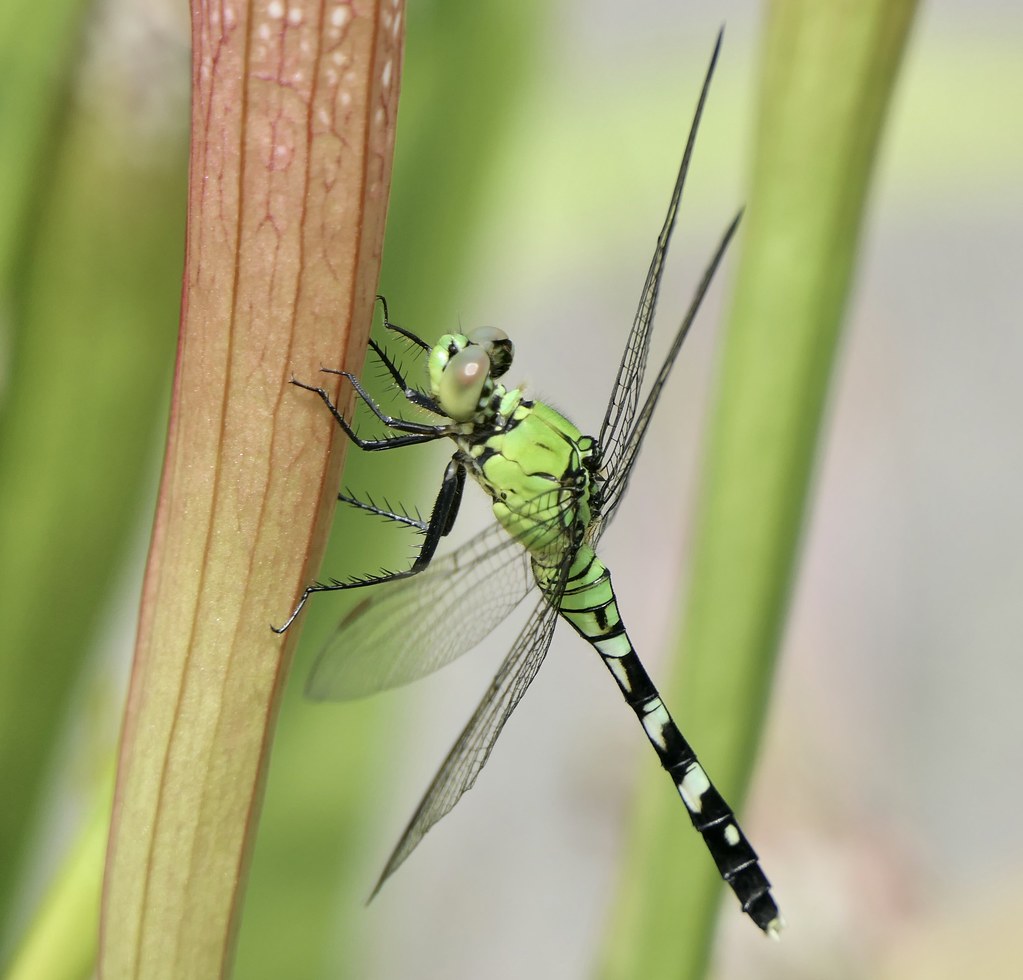   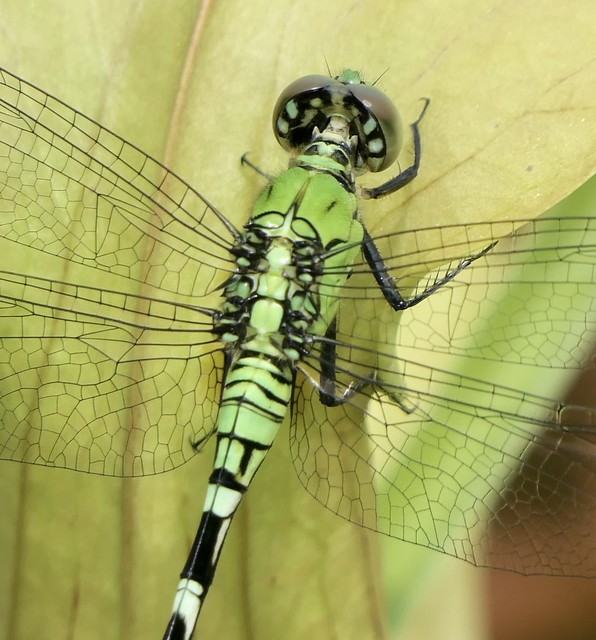 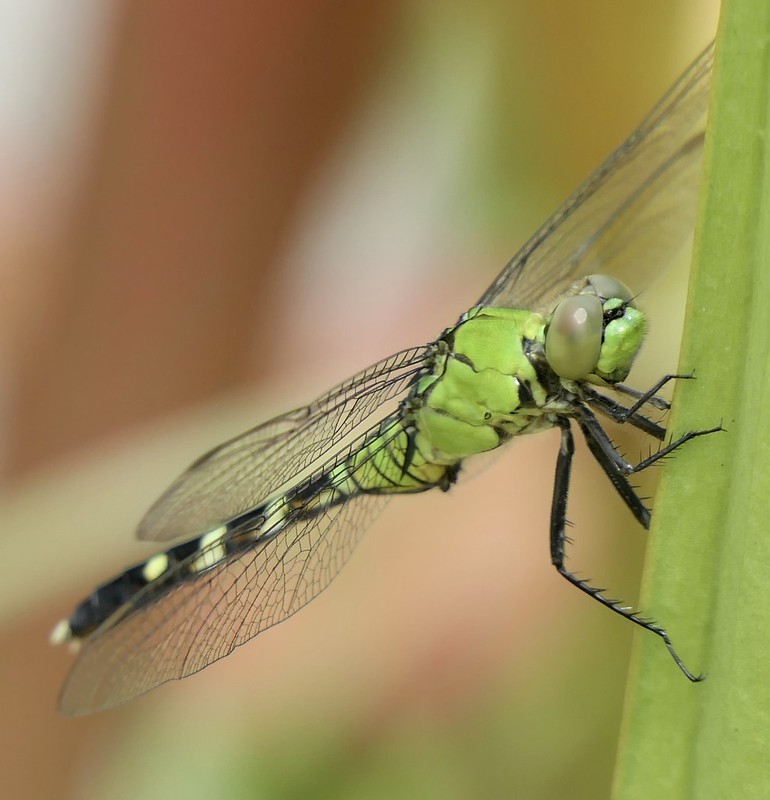  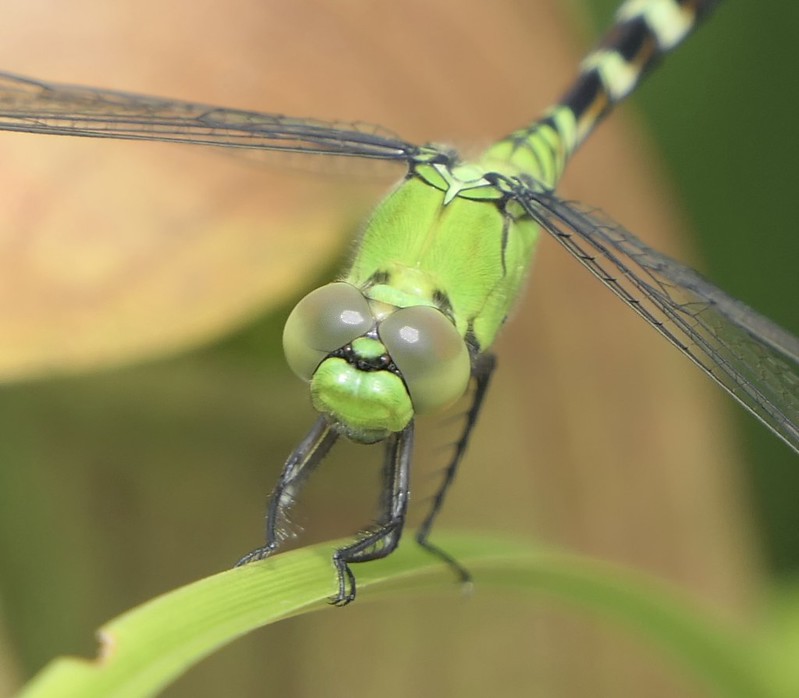 Shots were taken at the 500mm zoom setting of a 27mm to 500mm telephoto point and shoot allowing the camera to be about 3 feet from the nervous dragonfly. |
|
|
|
Post by jasoninsd on Jul 23, 2022 11:21:01 GMT -5
Jim, I absolutely LOVE your dragonfly pictures! The detail you capture on these critters is amazing! Thanks for taking the time to share those with us!!  |
|
rockbrain
Cave Dweller 
Member since January 2022
Posts: 3,172
|
Post by rockbrain on Jul 23, 2022 11:26:18 GMT -5
You got some amazing sharpness and pretty darn good depth of field. The color palette on those shots is amazing. We enjoy all the dragonfly activity around our back yard pond.
|
|
Deleted
Deleted Member
Member since January 1970
Posts: 0
|
Post by Deleted on Jul 23, 2022 13:05:30 GMT -5
jamespThose are some awesome pictures Jim! 
|
|
jamesp
Cave Dweller 
Member since October 2012
Posts: 36,606
|
Post by jamesp on Jul 23, 2022 13:29:12 GMT -5
Ha, blame the camera folks. I'll say my wife picked up an 'open box' Lumix FZ2500 from one of those New York cameral houses for $700. Crazy complicated camera but it takes fine photos. I bought a $20 help book to help understand it. Thanks mohs jasoninsd rockbrain ashley |
|
jamesp
Cave Dweller 
Member since October 2012
Posts: 36,606
|
Post by jamesp on Jul 23, 2022 13:36:18 GMT -5
You got some amazing sharpness and pretty darn good depth of field. The color palette on those shots is amazing. We enjoy all the dragonfly activity around our back yard pond. Well you chose an interesting insect to enjoy. Dragonflies are quite sophisticated in their behavior rockbrain. They are top of the food chain amongst insects. Thanks to the 500mm telephoto lens the camera is 3 to 4 feet away from the subject which really helps improve the depth of field. So these would really be considered telephoto shots and not macro shots. Similar to using a telescope as a microscope at say 10 feet away from subject. This reduces effects of shaking too. |
|
|
|
Post by mohs on Jul 23, 2022 14:26:51 GMT -5
Ha, blame the camera folks. I'll say my wife picked up an 'open box' Lumix FZ2500 from one of those New York cameral houses for $700. Crazy complicated camera but it takes fine photos. I bought a $20 help book to help understand it. Thanks mohs jasoninsd rockbrain ashleyAnd skill  |
|
jamesp
Cave Dweller 
Member since October 2012
Posts: 36,606
|
Post by jamesp on Jul 23, 2022 15:02:51 GMT -5
The trick is to take a seat 3 feet from the tallest plant stem(about 4' tall) within a 20 foot radius and close to water mohs. This high spot would serve as the prime and mhost visited roost for these ambush predators. Even better if you cut the adjacent foliage in that 20 foot radius down to a foot tall to accentuate the value of the high perch. Also, instead of a deer stand a 'dragonfly stand' would help to camouflage your presence and movements. |
|
|
|
Post by mohs on Jul 23, 2022 16:57:56 GMT -5
Luminox ought to see that photo
Give ya deeper discount
The way you made it perform
Your dragons seem less flitty than the ones in AZ
Of course they like -especially - your area better
Then the barren land of the Salt
Although that good advise
Like you say -they are territorial
not going to roost for any
ol mohs
Plus my camera doesn’t have the zoom ballz
Or clarity for that
And I ‘d have to be on tripod with a remote
Even if I had the patience
Though the dragons are due to arrive here soon
Seem like I’m pretty good at capturing them flying ha
Because they fly around me
threatening
the way you dialed in the preferences
and the optical preciseness
plus the know how patience is
well ya know
From a book I’m reading and you probably already know this
Lens maker Carl Zeiss and Ernest Abbe, in the late 1880's ,
figured out the physical limit of lens form for maximum magnification.
I would figure your aperture to be getting fairly close to that limit
The Natural world is intense and with the technology, and skill
Well those old naturalist are turning over
You know where
They could only study those bugs
that close up
stuck to a pin ha ha
|
|
|
|
Post by hummingbirdstones on Jul 23, 2022 17:57:54 GMT -5
Excellent photos, jamesp! Love that lime colored dragonfly. We have them flying around here, but mostly the red/orange ones. |
|
jamesp
Cave Dweller 
Member since October 2012
Posts: 36,606
|
Post by jamesp on Jul 23, 2022 22:42:05 GMT -5
Luminox ought to see that photo Give ya deeper discount The way you made it perform Your dragons seem less flitty than the ones in AZ Of course they like -especially - your area better Then the barren land of the Salt Although that good advise Like you say -they are territorial not going to roost for any ol mohs Plus my camera doesn’t have the zoom ballz Or clarity for that And I ‘d have to be on tripod with a remote Even if I had the patience Though the dragons are due to arrive here soon Seem like I’m pretty good at capturing them flying ha Because they fly around me threatening the way you dialed in the preferences and the optical preciseness plus the know how patience is well ya know From a book I’m reading and you probably already know this Lens maker Carl Zeiss and Ernest Abbe, in the late 1880's , figured out the physical limit of lens form for maximum magnification. I would figure your aperture to be getting fairly close to that limit The Natural world is intense and with the technology, and skill Well those old naturalist are turning over You know where They could only study those bugs that close up stuck to a pin ha ha The photos could have been improved Ed.(or in other words the auto mode could be improved with manual settings because the camera has more capability). AUTO mode picked f4.5 at 1/500. Not so good. Much better would be 'f8 at 1/125' or 'f11 at 1/60'. Because there was plenty of light to reduce the aperture opening to f8 or even a smaller f11. If shooting at 1/60 make sure you have a steady hand, 1/125 is safe to hold. f8 or f11 would increase depth and give a better overall photo. Note that the lowest available ISO of 125 was chosen and FIXED for a bright day and still shot. The lower ISO 125 gives richer sharper photos than ISO 400 or 800 or 1600. The photo was cropped from 5500x3700 down to 1212x1041, plenty of pixels for a laptop size screen. The camera has a 480mm telephoto zoom ability, so the lens is a bit like a telescope. A good analogy would be a TV video camera zooming in on a football player's face from way up in the stadium. Call it a 'long distance macro' that is much steadier than an up close macro with the lens 2 inches from the subject. No way to take close-up macro's of a hot jittery dragonfly ! Note that all of the above is in strong light with cloud cover. Had it been a blue sky bright day the camera could have shot at the yet smallest aperture opening available in this AF Macro mode on this particular camera: 'f13 at 1/125' ISO 125 Zoom at 480mm(+/- one meter from subject) Or this image in the brain to simplify that mess typed above lol(this is what I see for this camera/this situation when taking photos if in manual mode) :  This was the settings chosen by auto(except I fixed the ISO 125 and chose the 480mm zoom) 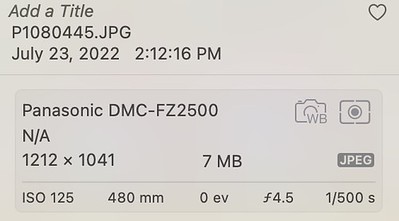 Hope this helps. |
|
jamesp
Cave Dweller 
Member since October 2012
Posts: 36,606
|
Post by jamesp on Jul 23, 2022 22:54:00 GMT -5
mohs This FZ2500 has a crazy wide range 24mm to 480mm zoom lens. It shouldn't have super good fidelity over such a giant range. There must be some poorly performing zoom ranges some how some way. It is one of the laws of optics. Fixed lens are tuned optically to best fidelity at that length. Zoom has to make exceptions to lens quality at some point between 24 to 480mm. Unless the electronics is making some kind of manipulations for the optical shortcomings of the crazy wide range lens. Nothing surprises these days.
|
|
jamesp
Cave Dweller 
Member since October 2012
Posts: 36,606
|
Post by jamesp on Jul 24, 2022 7:55:05 GMT -5
Excellent photos, jamesp! Love that lime colored dragonfly. We have them flying around here, but mostly the red/orange ones. There are likely other colors of them near you depending on where they get established. Over 3000 species in the world ! You might see other colors a mile or say 5 miles away. One variety seems to dominate a given wetland. This green variety is way outnumbered by the blue one at my place. There are at least 5 other varieties at my place, but they are all way outnumbered by the blue one. There is a large one that specifically feeds on dragonflies. |
|
|
|
Post by hummingbirdstones on Jul 24, 2022 8:57:48 GMT -5
Excellent photos, jamesp ! Love that lime colored dragonfly. We have them flying around here, but mostly the red/orange ones. There are likely other colors of them near you depending on where they get established. Over 3000 species in the world ! You might see other colors a mile or say 5 miles away. One variety seems to dominate a given wetland. This green variety is way outnumbered by the blue one at my place. There are at least 5 other varieties at my place, but they are all way outnumbered by the blue one. There is a large one that specifically feeds on dragonflies. There are green ones and blue ones, which are smaller generally than the red/orange ones. Those are huge! We just don't have them much out where I live. Every once in a while I'll see one, but not often. |
|
jamesp
Cave Dweller 
Member since October 2012
Posts: 36,606
|
Post by jamesp on Jul 24, 2022 9:49:46 GMT -5
They love swamps and hot shallow water hummingbirdstones. Some varieties prefer creeks and rivers, different ones seek a variety of habitats. I'll keep an eye out for red ones, so far I haven't seen a red one at my place. |
|
|
|
Post by hummingbirdstones on Jul 24, 2022 10:44:55 GMT -5
They love swamps and hot shallow water hummingbirdstones . Some varieties prefer creeks and rivers, different ones seek a variety of habitats. I'll keep an eye out for red ones, so far I haven't seen a red one at my place. These are the ones that I see most frequently: Flame Skimmer |
|
|
|
Post by mohs on Jul 24, 2022 11:01:56 GMT -5
|
|
jamesp
Cave Dweller 
Member since October 2012
Posts: 36,606
|
Post by jamesp on Jul 24, 2022 12:46:08 GMT -5
mohs, all that may look complicated. It really is not if you consider the most critical elements are f-stop, shutter speed, ISO setting, good focus. Always learn doing still shots in bright light. Best to leave the zoom fixed, it adds complexity. Focus is easy. ISO is easy, just pick the lowest ISO for given lighting and/or motion. Still shots in bright light is easy, use ISO 125 or 200. The final concern is the f-stop/shutter speed relationship. Those two are the key to great photos. Study these two well. Digital camera controls is where the confusion lies no doubt. You computer or smart phone may have 'i' usually in a circle. click 'i' to get the 'information' for a given photo. that will tell you the settings that the computer's brain in the camera picked for a given 'auto' shot. You should be able to improve most 'auto' shots. Often 'AUTO' picks a higher shutter speed and lower(f4.5) f-stop. Better a lower shutter speed to raise the f-stop from say f4.5 to say f11 for a better depth of field. Those are rough examples. It is far better to learn on a simple camera. Like an old 35mm film camera that does not have all those dang bells and whistles. It is also better to master one digital camera. Buy another different brand and you have to re-learn the new beast's icons, controls, settings, etc. grrrr Lens diagrams really help to understand optics and optical relationships. A basic educational optics textbook has such diagrams. Focal lengths, ratios, lens diameters, etc effecting lensatic operation is better learned from diagrams. Best to start with the way a simple refractor telescope works since it is a basic camera arrangement. Guys like this will help you a lot: Other similar Youtube videos will get you fixed up. You are way smarter the optical mechanics, trust me.
|
|
jamesp
Cave Dweller 
Member since October 2012
Posts: 36,606
|
Post by jamesp on Jul 24, 2022 13:36:08 GMT -5
The Flame Skimmer is too cool hummingbirdstones. Interesting that it stays within just Arizona for the most part. That site for just Arizona is amazing. Such diversity. Nature rocks. Wow, looking at the large number of varieties just around Arizona... |
|
|
|
Post by mohs on Jul 24, 2022 14:06:42 GMT -5
Thanks  James Paul from Brisbane is excellent My type of teacher Clear concise information & fabulous sunset pictures!!! I personally wrote him just to thank him for those attributes He wrote back |
|















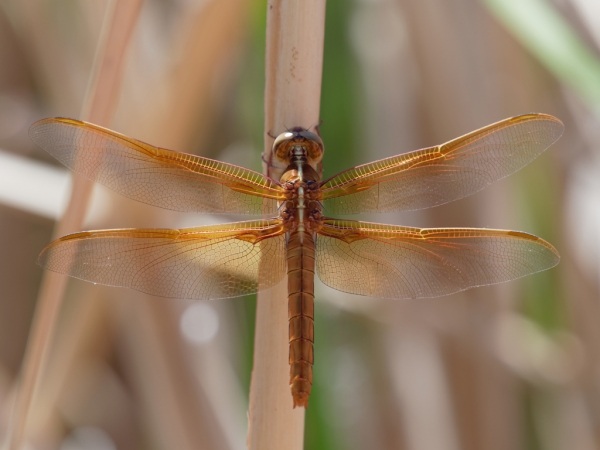
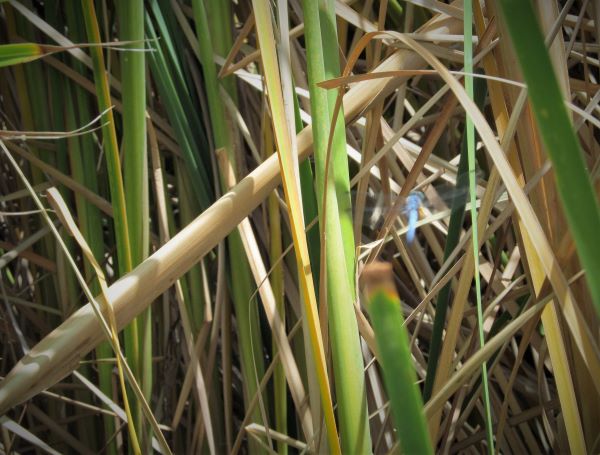

 James
James 









